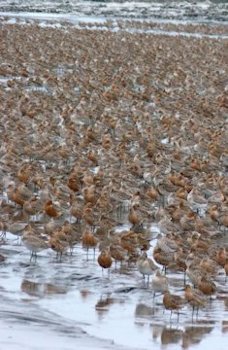
|
Birds Fueling for the Journey
Flying is a strenuous activity, and even though birds are marvelously adapted to their aerial life, with super-efficient hemoglobin, a lung and air-sac system that allows for maximum oxygen intake, and hollow bones, a calorie is still only a calorie, and it takes a lot of them to propel a body through the air over hundreds of miles. As the season of migration approaches, signaled by the changing length of the day, as well as by built-n biological clocks, a birds metabolism changes and it begins to deposit stores of fat under its skin. In species that make long, nonstop flights, the amount of fat deposited can be quite impressive equaling half their body weight or more. A single flight exhausts a large proportion of these "fuel tanks," which must then be replenished before the next leg of the journey. For this reason, it is vitally important for migrating birds to find good, stable food supplies during their journey as well as before it. Stopover sites where fat stores can be replenished quickly can therefore be every bit important to long-distance migrants as suitable nesting and breeding grounds. Bar-tailed Godwits roost at a key refueling spot on their northward migration Every spring, tens of thousands of Bar-tailed Godwits drop down onto the wetlands of China's Bohai Bay, ravenous after traveling 3,000 miles from Australia. This Yellow Sea stopover point is crucial for the birds, called red knots, to rest and refuel for the second leg of their journey, which will take them another 2,000 miles up to the Arctic tundra. Return to Bird Migration and NavigationSee Monthly Changes in Daylight Hours ⇨ |
| Bar-tailed Godwits |